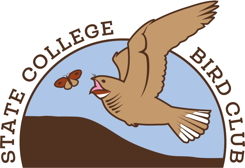State College
Bird Club Meeting
October 28, 2020
Online Zoom Meeting
Presiding: Doug Wentzel
Recording: Peggy Wagoner Saporito
Attendance: 40
Treasurer’s report (Jean Miller): $304 spent on logo redesign;
$235 received in dues. (Mail-in dues are still being accepted, see
website)
Zoey Greenberg, membership chair, commented on the impressive
support and enthusiasm for the bird club within the State College
community.
Announcements:
Thanks to Nick Kerlin, for his tireless dedication during the
past ten years, as bander-in charge of bird banding at the
Arboretum Avian Education Program.
The new logo is completed and ready for use. Thanks to Susan
Smith, Nick Bolgiano and Jon Kauffman who worked with designer,
Alissa Pendorf.

Jen Lee is nearly finished with the checklist update that will
include the new bird club logo.
Thanks to Jim Dunn, who will be stepping down this year, for his
contributions during the past 18 years as primary complier of the
State College Christmas Bird Count. Bob Fowles will continue in
the role of co-complier. Email Doug
if you are interested in either serving on a committee to find
the next compiler, or if you would like to be considered for the
primary complier position.
Although there are no field trips scheduled at this time, the
Christmas Bird Count is coming up on December 20 in both
Huntingdon and Centre counties.
Interesting Bird Sightings: Greg Grove’s Summary
Greg highlighted a number of interesting and unusual sightings
in the area since late September, including scoters, shorebirds,
warblers and the arrival of fall sparrows and winter finches
including some Evening Grosbeaks. Greg reminded us that dreary,
rainy autumn days are the times we should head to places like Bald
Eagle State Park and Lake Perez to view “fallouts” of waterfowl
unable to continue their fall migration until the weather clears.
At the Stone and Jacks Mountain hawk watches there have been good
flights of Accipiters (3rd highest year for Sharpies at Stone) and
falcons, including good numbers of Kestrels. There have been
record low numbers of Osprey however. Golden Eagles have begun to
migrate and should continue to be seen at hawk watches through
November on those blustery west-to-northwest windy days.
Speaker: Brandon Hoenig: Stream Bugs Make Strong Birds: The
importance of aquatic prey for the development of nestling
Louisiana Waterthrush
(This entire presentation can be viewed here)
Brandon, a PhD candidate at Duquesne University in Pittsburgh has
been studying Louisiana Waterthrush (LOWA) at Powdermill Nature
Reserve in Westmoreland county. By combining traditional
field research with lab-based techniques, Brandon has been
studying the impacts of prey availability on both nestling and
adult LOWA and implications for long-term conservation.
Considered a bioindicator species, this wood warbler prefers
healthy forested streams and nests directly in stream banks.
Waterthrush rely heavily on aquatic insect prey such as stoneflies
and mayflies which are higher in fatty acids as compared to
terrestrial insects such as moths and true flies. Even when
nestlings are fed lower quantities of fatty-acid-rich stoneflies
and mayflies, they have greater mass than young that are fed
larger quantities of terrestrial insects.
Stonefly and mayfly populations are known to be lower to
non-existent in poor quality acidified streams such as those
impacted by abandoned mine discharge. Studies have shown that more
breeding pairs are found in high quality streams, and nestlings
have longer wings and greater body mass than those raised in
acidified stream habitats. Brandon compared impacts of high
quality vs. acidified stream habitats on nestling diets and
development as well as adult LOWA behavior.
Multiple fecal sacs from 5-7 day old nestlings were used to
extract prey DNA to determine which insect species nestlings were
being fed and to estimate frequency of occurrence. Stable isotope
analysis was used to determine the percentage of each prey species
in the diet of each nestling. As anticipated, diets of nestlings
raised in high quality habitats were dominated by high quality
prey – primarily mayflies and stoneflies. In acidified stream
habitats, lacking mayflies and stoneflies, nestlings’ diets
consisted of a variety of lower quality terrestrial prey species.
As a result body condition of nestlings in high quality streams
areas was better than those raised in acidified stream habitats.
The behavior of adult LOWA is also impacted by availability of
prey species. Mayflies are more prevalent early in the season
which can help explain why waterthrushes are among the first
migrants back on breeding grounds. LOWA begin establishing
territories as early as mid March to take advantage of early
aquatic insects.
Brandon found differences between early (mid May) vs. late (mid
June) broods reflecting prey availability. In early broods,
mayflies made up 75% of nestling diets and only 50% of diets in
late broods. Later broods had more terrestrial insects represented
in their diets. Duration of foraging trips (time adults spent away
from the nest to find food for nestlings) averaged 7.5 minutes for
early broods and increased to 10 minutes in later broods. This
indicates that parent birds may be having more difficulty finding
prey later in the season when mayflies are not as prevalent. The
adults may have to travel further afield to find prey. In
addition, early broods typically have 5-6 nestlings whereas later
broods have 3-4 nestlings.
This research, focusing on impacts of insect prey on the health
and behavior of a bird species, highlights the importance of
considering prey in avian conservation efforts. The fact that both
LOWA and trout require healthy streams with an abundance of the
same aquatic arthropods could lead to collaboration between
fishermen and birders in efforts to support these habitats. In
addition, broader implications of climate change resulting in
seasonal shifts in bird and prey insect phenology were briefly
discussed.
